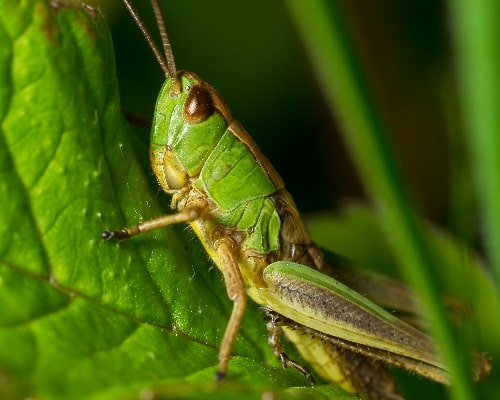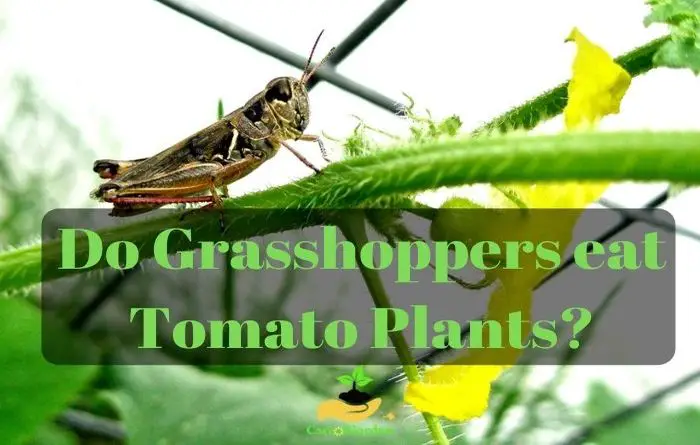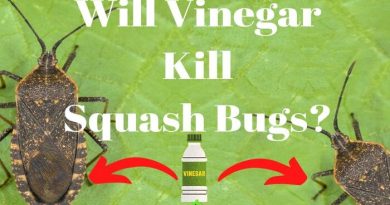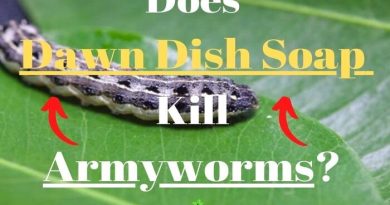Do Grasshoppers eat Tomato Plants? (How to Keep Them Away)
Grasshoppers are herbivorous insects that eat mainly plants feeding on leaves, vegetables. But the question we are asking today is: Do Grasshoppers eat Tomato Plants?
Some grasshoppers are considered herbivores or grass eaters, while most are classified as polyphagous.
The feeding behavior of grasshoppers depends entirely on their preference for specific foods. Grasshoppers can be found in at least 75% of the world’s countries where wet, field conditions lend themselves.
Do Grasshoppers eat Tomato Plants
Grasshoppers consume plants such as cabbage, kale, beans, peas, eggplant, bell pepper, fennel, okra, celery, lettuce and also tomato plants.
Grasshoppers can cause significant damage to tomatoes by chewing them causing tomato leaves to curl, resulting in loss of fruit and even killing plants. They eat almost every part of the tomato plant, starting with the leaves and flowers. Also they transmit many microbes that can cause devastating tomato plant diseases
Mild infestations may cause only minor damage, such as a few lost leaves, but large numbers of grasshoppers can eat whole tomato plants along with other vegetables in the garden. Although they prefer young tomato plants, grasshoppers eat mature tomato plants as well. Damage usually occurs quickly, within a day or two with heavy infestations.
Usually grasshoppers will eat the flowers of the plant and thus preventing the fruit to be created by the plant even if the plant survives.
Grasshoppers prefer to eat common vegetable such as: cabbage, lettuce and beans, but they will also eat the leaves of tomato plants.
Grasshoppers are polyphagous, meaning they depend on several species of plants. The growth of polyphagous grasshoppers depends on the number of plants they chew on. They will also eat cowpeas, maize, peaches, figs, citrus fruits and peanuts.
How to Prevent Grasshopper’s from Eating Tomato Plants

As soon as grasshoppers are spotted, treatment should begin. If the infestation is light, removal by hand or with nets is the easiest way to stop the damage. Collected grasshoppers should be killed.
Choosing tomatoes early in the season is also an effective strategy to prevent fruit loss to grasshoppers. Since insects usually cause the most damage in late summer when other food sources have been depleted, tomatoes that produce fruit before grasshoppers become adults are a good choice for areas prone to heavy infestations or where prevention and control are difficult.
Early season tomatoes are available for almost every type of tomato. Some of the most popular early season varieties of tomatoes are Early Girl, Early Wonder, Oregon Spring, Siberia, Sprite, Tiny Tim, Macero Roma and Bellstar.
1) Stopping an infestation before it starts is the best way to limit damage to tomato plants. Plow the land in the garden and surrounding the garden in the fall. This will destroy most grasshopper eggs, disrupting the grasshopper’s life cycle.
2) The most effective way to prevent an infestation is to grow thick, tall grass in the garden, which discourages grasshoppers.
3) Another way is to spray them with soap or organic pesticides or sulfur powder.
4) Natural predators like ducks and chickens can drive away or eliminate some of the harmful grasshoppers. It is interesting to have these animals to learn how to repel grasshoppers.
5) Natural insecticides that are made from neem oil can go a long way in eliminating these insects. If all these natural solutions do not work, we are going to use chemical pesticides. In addition to this, you can plant lemon balm and garlic. The smell deters most insects.
You can easily remove bindweed from garden by following this easy guide!
How to know if there are grasshoppers in the tomato garden?
Grasshoppers grow from 3/4 to 2 inches (1.90 cm to 5.08 cm) long, but some can be much smaller or much larger. Compared with crickets ,the grasshoppers have shorter antennae and larger hind legs. To recognize them: the grasshopper has antennae of a length almost equal to that of its body whilethe locust has only small antennae.
The color of grasshoppers in nature depends on the habitat, is an excellent camouflage and can combine different shades of the same color (for example, green), as well as bright spots or spectacular stripes.
You will know that you have grasshoppers around your tomato garden if you see the insects (take a good look at the plants, since when they are young they can be confused with them), or if you find the tomato leaves bitten.
Most grasshoppers do not attack specific plants. These insects usually prefer young, tender shoots, but can feed on all types of plants and all parts of plants. Their large chewing mouths do great damage, instead of chewing small holes, grasshoppers can consume large sections of leaves, flowers, vegetables, and fruits.
They make holes in the tomato plant tissue as well as in the tomato leaves. Dark droppings can also be found on the leaves of the tomato plant.
Grasshoppers can’t get very far until they reach maturity because they don’t have wings, but once winged they can fly several kilometers in search of new food sources.
How to Remove Grasshoppers from Tomato Plants
1.Using Garlic
To keep grasshoppers away from tomato, you can do the following:
- Chop one or two cloves of garlic and spread them over the potting soil: these insects have a very delicate sense of smell, so much so that they hate the smell of garlic.
- Make garlic infusions (1 clove per liter of water) and spray the tomato plants: if they decide to eat the tomato leaves, they will only be able to take a bite. Then they will go away.
- Chop up a Padron pepper, and boil it in 1l of water and then spray the tomato plants: we all know how spicy these vegetables can be.
- Acquire the natural insecticide Neem Oil to treat your pots or the garden: it does not harm the environment, and it also helps to repel and combat other pests, such as aphids or red spiders.
- Protect the tomato plants with a mesh with very small holes: it is true that it will not look very aesthetic, but if you have few plants it can be a solution.
- Catch and release them far away, at least 50 meters away from the garden: it is an option that can be temporary, since there is no way of knowing if you will see them again.
2. Using neem oil
Here is how to remove grasshoppers using neem oil:
- Add 10ml of neem oil to 100ml of water in a bottle.
- Mix well and spray the solution on the tomato plants to protect them from grasshoppers and other pests.
- You should apply it as soon as possible because neem oil is effective against both grasshopper nymphs and larvae of other harmful insects.
Neem oil is a natural insecticide which reduces or stops insect growth and sterilizes certain species.
3. Natural grasshopper insecticide recipe
To continue with natural tips and repellents, here is an insecticide recipe that is easy to make at home using a few ingredients.
For this grasshopper insecticide you need:
- 3 cups cold water
- 1 tablespoon of liquid dish soap
- 1 tablespoon of baby oil
- 2 tablespoons baking soda
Mix all the ingredients well and spray on the tomato plants and flowers that you want to protect from grasshoppers.
If you want to easily remove any bugs in the garden soil you need to follow this amazing tutorial!
When do grasshoppers attack home gardens?
It is mainly in the countryside, or at least outside the cities, that grasshoppers really harm home gardens.
Typically, a garden susceptible to grasshoppers attack is surrounded by agricultural fields or natural meadows. At some point, usually in mid to late summer, the grasshoppers, having ravaged the nearby fields, leave them and migrate to the gardens.
How do grasshoppers eat?
Grasshoppers ‘ antennae have taste buds that they use to taste food before eating it. In this way, they select the one that interests them and discard the one that does not, keeping the one that is fresher and of higher quality.
Once this is done, they carefully grind the food with their jaws, creating a kind of porridge to digest it better and swallow it.
Conclusion
There are indeed grasshoppers that eat almost every type of plant including tomato. Grasshoppers who prey on tobacco also tend to eat tomato plants, eggplants, and peppers plants and can transmit the tobacco mosaic virus to your tomatoes. There are also grasshoppers that favor ornamental plants, such as rose grasshoppers.
Frequently Asked Questions
Although the grasshopper’s diet is primarily based on grass , they may eat other foods such as flowers, stems, seeds, grains, fruits, and vegetables. You can offer them lettuce, spinach, Swiss chard, grated carrots, tomatoes, strawberries and melons.
Mix one part of apple cider vinegar with three parts of water and add 5 g of pure soap flakes. Pour the mixture into a large insecticide sprayer. Spray the solution early in the morning on all leaves, stems and grasshopper soil . If you see grasshoppers , soak them thoroughly with the solution.
Yes, crickets can eat tomatoes . In fact, some species are considered pests for tomato crops and other solanaceous plants, such as tobacco . However, it is not recommended to abuse the fruits of this plant family, including eggplant and pepper, as they contain natural insecticides that are toxic to many types of insects.




